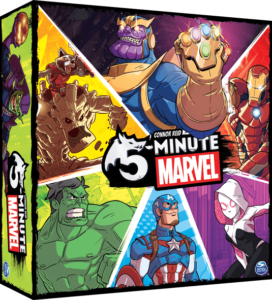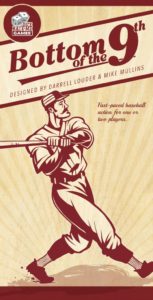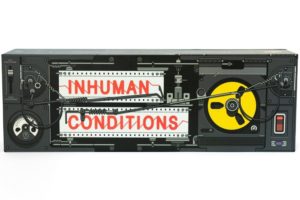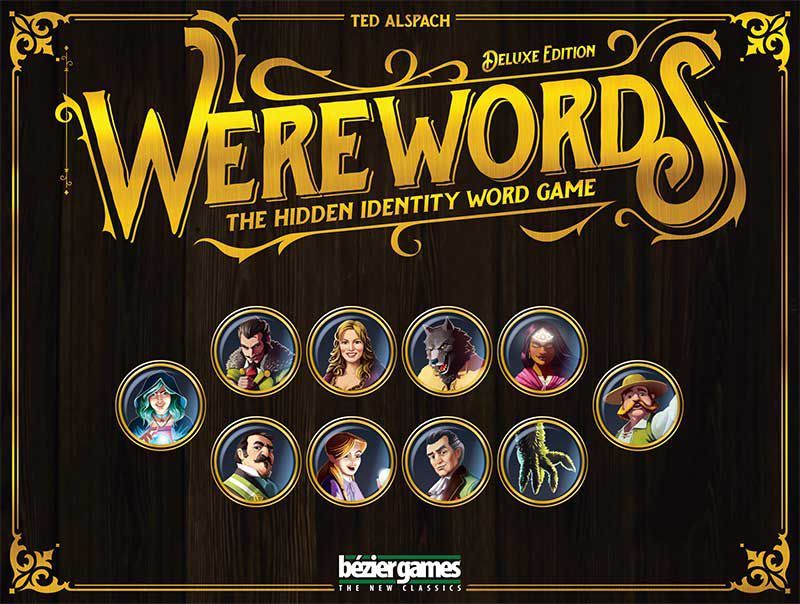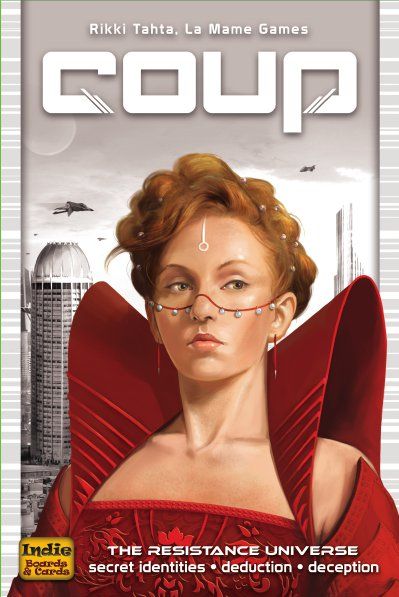Hey everyone! One of my goals with the design of Pocket Paragons was to create a game that was quick to play and even quicker to learn!
Today’s Pocket Paragons design blog is gonna be a little different than the usual. Instead of a character breakdown, here are a few of my favorite other games that pack a lot of fun and decision making into a small time frame, just like Pocket Paragons!
– Brian McKay
In 5-Minute Marvel, you and your friends team up as Marvel superheroes to defeat an entire stack of villains in a 5-minute window by playing symbols to match the enemy weaknesses quickly but without wasting valuable resources. 5-Minute Marvel is a standalone sequel to 5-Minute Dungeon, and I prefer it because it splits the player’s deck into generic cards and powerful special cards, letting you choose when to draw your best plays. This extra layer of decision and strategy takes an already great game and pushes it to the top.
Bottom of the 9th
Bottom of the 9th is a baseball game that simulates the tense end of a close baseball game. It’s asymmetrical– one player plays the batting offense and the other plays the pitching defense for the entire game. Reading what pitch the opponent is going to throw is a mechanic I’m obviously fond of, and it captures the flavor of real baseball very well in that regard. The pitcher is limited in how often they can use their stronger pitches before they tire out, and there’s frantic dice rolling when trying to make it on base before you’re thrown out.
Escape: The Curse of the Temple
Speaking of frantic dice rolling, this game is probably the most frantic of these games. In Escape: The Curse of the Temple, you and your friends are trying to loot and escape the temple before the 10-minute timer traps you all in! You roll your dice to move around, but each die has a cursed face that prevents it from being rerolled, so you have to use your golden die faces to help cure your friends. The game comes with a soundtrack that includes a gong that triggers extra panic as you scramble to reach a safe spot or risk losing one of your dice for the rest of the game. It’s a ton of fun, even if people won’t play it a second time for fear of having a heart attack.
KLASK
KLASK is like air hockey, but with wood and magnets. You control your playing piece by holding a magnet under the wooden table it comes with, and then you move it around to knock a ball, hopefully into your opponent’s goa66l. There are also smaller magnets on top of the table that cause a point to score if two of them get attached to your playing piece, so there’s an alternate strategy to use the ball to knock those little biscuits into your opponent’s piece (or at least on their side of the board, to limit their mobility). The different ways to win each round give this game a layer of strategy which is a huge boost to an otherwise pretty simple and fun game.
FUSE
FUSE is a cooperative dice game, but it doesn’t feature the frantic rolling that Escape does. In this game, you and your teammates are trying to defuse all the bombs by matching the right colors and numbers on their dice to their bombs. The theme doesn’t quite fit, but it’s still a lot of fun. The difficulty of the game comes from trying to divide dice that everyone needs out of a very limited pool, and do it quickly enough to get to the next set of dice. It’s a game that can really test the players’ wills, as you have to know when to give up dice you need, and when to stand up and insist that there is nothing more important to you in life than this green six.
Inhuman Conditions
Inhuman Conditions is a social deduction game, but for only 2 players. I know those two concepts sound opposite to each other, but it’s a great thematic experience where one inspector is trying to determine if the other player is secretly a robot trying to murder them. If the player is a robot, they have some rules to follow, and it’s really hard to try to sneak those into regular conversation, but it’s equally hard for the inspector to try to pick up on everything. The rulebook and components are out of this world, and while the game plays in 5 minutes, it’s so easy to pour hours into going through all the different character themes and conversation topics that the game serves up.
Dracula’s Feast: New Blood

Dracula’s Feast is a deduction game that plays up to 8 players. You’re monsters at Dracula’s masquerade, and you’re trying to figure out everyone’s identities by asking yes/no questions or “dancing” with a partner where you show each other your secret roles. There’s a tough balance to walk there, as dancing gives you more useful information while giving an opponent lots of free info as well. The secret roles also come with unique powers, so be careful who you ask to dance! New Blood is a reprint with additional cards and fantastic art, so I recommend it over the original Dracula’s Feast. The sequel, Night of the Mummy, I didn’t enjoy as much, because so many of the roles in that game punished you for dancing, which was the mechanic I enjoyed the most from the original.
(3rd Place) Automata NOIR
Automata NOIR is a two-player game where a detective is hunting a killer with two separate identities. Another great asymmetric game, the game takes place on a 5×5 grid of 25 potential suspects. Both players know who they are on the board, and are in a race to deduce their opponent’s identity before they get arrested or killed by the other player. The killer can switch between two different identities which is the chef’s kiss of this game, giving them an escape plan and making it so much harder for the detective to keep all their clues straight. There are other modes that expand the game to higher player counts, but the Killer vs Inspector mode is where the real game is at. This game also implements an older game simply titled Noir, but I prefer this edition for the Penny Arcade art and worldbuilding.
(2nd Place) Werewords
Werewords is one of the few games I’ve given a perfect 10 BGG rating to, but it’s probably my favorite party game. It combines the classic Mafia/Werewolf style social deduction with good old fashioned Twenty Questions. The players are trying to find a magic word that will cause the Werewolf to lose, but they can only figure it out by asking the silent Mayor yes/no questions. The Werewolf is also asking bad questions to try to steer the thought train down the wrong track while not being too obvious about it that they out themselves. The newer editions of Werewords fix my only issue with its original print run– the god awful art. With its new art style, I can easily recommend this game with no “ifs” or “buts”.
(1st Place) Coup
Not only does Coup also have a perfect 10 BGG rating from me, but it’s also my favorite game of all time. It takes my favorite game elements, bluffing and deduction, and distills them into a game that is easy to pick up and hard to stop playing. Players begin to pick up the strategy as they play, and each playgroup I’ve introduced it to has evolved in different ways. With only five roles of three cards each, there’s still an endless well of combinations and strategies that lead to the game being fresh each time. I would only advise you to stay away from the Inquisitor expansion role which I think ruins the game entirely. The Rebellion G54 standalone adds new roles in a better way, but I think the simplicity of base Coup is the best gaming experience there is. I’ve played Coup so much that my cards have been worn to the point where I’ve had to buy a new replacement copy– twice.
Like greats under 10 minutes? Try out ours, Pocket Paragons, now available for pre-order.
Thanks for reading today’s Pocket Paragons design blog! We hope you enjoyed it!
